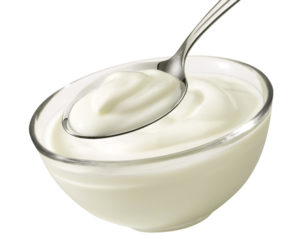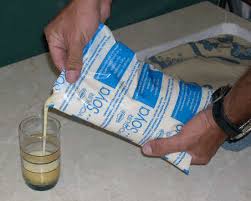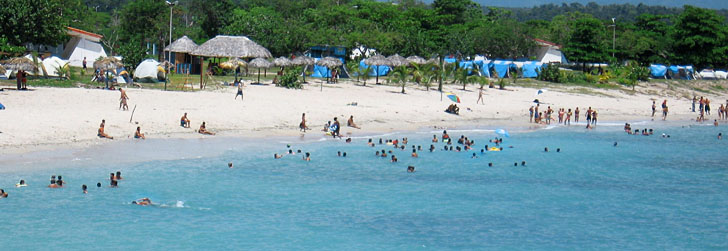Yogurt – is also known as yogurt, yogurt, yogurt or yagurt, although the Royal Spanish Academy (RAE) recommends the form “yogur” – it is a dairy product obtained through the bacterial fermentation of milk.
Although any type of milk can be used, in Cuba soy milk is used, due to the scarcity and difficulties in the supply of cow’s milk.
In the cow’s milk is the fermentation of lactose (milk sugar) in lactic acid is what gives yogurt its texture and flavor so distinctive. Often chocolate, fruit, vanilla and other flavorings are added, but it can also be made without adding them.
In the fifties, in Cuba, the development of the production of yogurt, processed from cow’s milk and marketed under the name of Yogurt Balkán, mimicked the producers of the Balkan nations of Eastern Europe, although in the At that time, there was no tradition for its consumption and, on the other hand, production was limited to the capital, with a price higher than that of pasteurized cow’s milk.
This yogurt corresponded to the classic natural formula, was made with the bacterial strains of Lactobacillus acidophillus bulgaricus and Streptococcus thermophyllus and was only sold to the population in limited specialized markets.
Since 1959, 50 years ago, the diversification of its production began at the national level, as it became a scarcely consumed and hardly available dairy derivative, in general, an indispensable supplement to university student dining halls and the residency of scholarship holders that were beginning to create in the early sixties, first in the capital and then in other provincial capitals of the interior of the country.
With the arrival in the country of a large number of technicians and advisers from European countries, who participated in different activities of social life, they also reached their eating habits and, among them, the promotion of yogurt, which transcended as an important nutrient that it was generalized during that time, to become the dairy of main preference of many Cubans.
At the end of the seventies the Research Institute for the Food Industry (IIIA) was created, a modern center of studies and the only scientific institution of the Ministry of the Food Industry, which played a decisive role in the development of new forms of production.
This modern center, located west of the capital, in the municipality of La Lisa, 25 km from the center of the city of Havana.
In the decade of the nineties, there came a period during which severely affected the population’s diet: the economic crisis known as the “special period”, triggered by the disintegration of the Soviet Union and the fall of the countries of socialist economy. Eastern Europe.
Then the decision was made by the country’s management, the Ministry of Food and the IIIA to develop and produce soy yogurt on an industrial scale, especially for children and adolescents, given the severe limitations of acquiring whole milk in dust in traditional international markets.
With the soy yogurt has been reached a variety of flavors, such as strawberry, raspberry, banana, coconut, pineapple, peach, orange-pineapple and orange, although its production is often difficult due to the effects of the production system and distribution.
EL YOGUR Y SU PRODUCCIÓN EN CUBA.
El yogur – es también conocido como yogurt, yogourt, yogurth o yagurt, aunque la Real Academia Española (RAE) recomienda la forma «yogur»— es un producto lácteo obtenido mediante la fermentación bacteriana de la leche.
Si bien se puede emplear cualquier tipo de leche, en Cuba se usa la leche de soya, por la escases y dificultades en el abastecimiento de la leche de vaca.
En la de leche de vaca es la fermentación de la lactosa (el azúcar de la leche) en ácido láctico es lo que da al yogur su textura y sabor tan distintivo. A menudo, se le añade chocolate, fruta, vainilla y otros saborizantes, pero también puede elaborarse sin añadirlos.
En la década de los cincuenta, en Cuba surge el desarrollo de la producción de yogur, procesado a partir de leche de vaca y comercializado con el nombre de Yogur Balkán, remedando a los productores de las naciones balcánicas de Europa del Este, aunque en el país en esos momentos, no había tradición para su consumo y, por otra parte, la producción se limitaba a la capital, con un precio superior al de la leche de vaca pasteurizada.
Ese yogur correspondía a la fórmula clásica natural, se confeccionaba con las cepas bacterianas de Lactobacillus acidophillus bulgaricus y Streptococcus thermophyllus y solo se expendía a la población en limitados mercados especializados.
A partir de 1959, hace ya 50 años, comienza la diversificación de su producción a nivel nacional, al convertirse de derivado lácteo escasamente consumido y poco disponible, en general, a suplemento indispensable de los comedores estudiantiles universitarios y las residencias de becarios que se comenzaban a crear a principios de la década de los sesenta, primero en la capital y después en otras capitales provinciales del interior del país.
Con el arribo al país de un gran número de técnicos y asesores de países de Europa, quienes participaban en distintas actividades de la vida social, llegaron también sus hábitos alimentarios y, entre ellos, el fomento del yogur, que trascendió como un importante nutriente que se generalizó durante esa época, para convertirse en el lácteo de principal preferencia de muchos cubanos.
A finales de la década de los setenta se crea el Instituto de Investigaciones para la Industria Alimenticia (IIIA), moderno centro de estudios y única institución científica del Ministerio de la Industria Alimenticia, que jugó un papel decisivo para el desarrollo de nuevas formas de producción.
Este moderno centro, situado al oeste de la capital, en el municipio de La Lisa, a 25 km del centro de la ciudad de La Habana.
En la década de los noventa, sobrevino una etapa durante la cual se afectó severamentel la alimentación de la población: la crisis económica conocida como “período especial”, desencadenada por la desintegración de la Unión Soviética y la caída de los países de economía socialista de Europa del Este.
Entonces se tomó la decisión por parte de la dirección del país, del Ministerio de la Alimentación y del IIIA de desarrollar y producir a escala industrial el yogur de soya, en especial para los niños y adolescentes, ante las severas limitaciones de adquirir leche entera en polvo en los tradicionales mercados internacionales.
Con el yogur en Cuba se han alcanzado una gran variedad de sabores, como fresa, frambuesa, plátano, coco, piña, melocotón, naranja-piña y naranja, aunque su produccion se ve en dificultades en muchas ocasiones por las afectaciones del sistema de producción y distribución.
Agencies/Wiki/CiberCuba/Various/Internet Photos/ Arnoldo Varona/ TheCubanHistory.com
THE CUBAN HISTORY, HOLLYWOOD.










